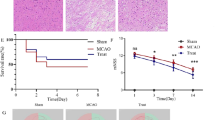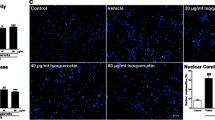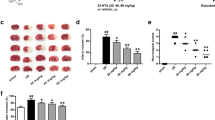Abstract
Trans-cinnamaldehyde (TCA), an essential oil in cinnamon powder, may have beneficial effects as a treatment for stroke which is the second leading cause of death worldwide. Post-ischemic inflammation induces neuronal cell damage after stroke, and activation of microglia, in particular, has been thought as the main contributor of proinflammatory and neurotoxic factors. The purpose of this study was to investigate the neuroprotective effects of TCA in an animal model of ischemia/reperfusion (I/R)-induced brain injury and the neuroprotective mechanism was verified in LPS-induced inflammation of BV-2 microglial cells. Our results showed that TCA (10–30 mg/kg, p.o.) significantly reduced the infarction area, neurological deficit score and decreased iNOS and COX-2 protein expression level in I/R-induced injury brain tissue. It inhibited 0.5 µg/ml LPS-induced NO production in BV-2 microglial cells without affecting cell viability, reduced protein expression of iNOS and COX-2, and attenuated inhibition of p53 protein. TCA also suppressed the effects of LPS-induced nuclear translocation of NF-κB p65 and p50 and increased cytosolic IκBα. It also reduced LPS-induced mRNA expression of iNOS, COX-2, and TNFα. We concluded that TCA has a potential neuroprotective effect to against the ischemic stroke, which may be via the inhibition of neuroinflammation through attenuating iNOS, COX-2 expression and NF-κB signaling pathway.







Similar content being viewed by others
References
Adams, T. B., Cohen, S. M., Doull, J., Feron, V. J., Goodman, J. I., Marnett, L. J., et al. (2004). The FEMA GRAS assessment of cinnamyl derivatives used as flavor ingredients. Food and Chemical Toxicology, 42, 157–185.
Amalaradjou, M. A., Narayanan, A., Baskaran, S. A., & Venkitanarayanan, K. (2010). Antibiofilm effect of trans-cinnamaldehyde on uropathogenic Escherichia coli. The Journal of Urology, 184(1), 358–363.
Anderem, A., & Ulevitch, R. J. (2000). Toll-like receptors in the induction of the innate immune response. Nature, 406(6797), 782–787.
Anderson, K. M. (2000). Toll signaling pathway in the innate immune response. Current Opinion in Immunology, 12, 13–19.
Baeuerle, P. (1991). The inducible transcription activator NF-kB: Regulation by distinct protein subunits. Biochimica et Biophysica Acta, 1072, 63–80.
Baeuerle, P. A., & Baltimore, D. (1988). I kappa B: A specific inhibitor of the NF-kappa B transcription factor. Science, 242(4878), 540–546.
Baeuerle, P. A., & Henkel, T. (1994). Function and activation of NF-kappa B in the immune system. Annual Review of Immunology, 12, 141–179.
Baldwin, A. S, Jr. (1996). The NF-kappa B and I kappa B proteins: New discoveries and insights. Annals Review of Immunology, 14, 649–683.
Baldwin, A. S. (2001). Control of oncogenesis and cancer therapy resistance by the transcription factor NF-kappaB. Journal of Clinical Investigation, 107, 241–246.
Ballabeni, V., Tognolini, M., Giorgio, C., Bertoni, S., Bruni, R., & Barocelli, E. (2010). Ocotea quixos Lam. Essential oil: In vitro and in vivo investigation on its anti-inflammatory propertie. Fitoterapia, 81(4), 289–295.
Bederson, J. B., Pitts, L. H., Germano, S. M., Nishimura, M. C., Davis, R. L., & Bartkowski, H. M. (1986). Evaluation of 2, 3, 5-triphenyltetrazolium chloride as a stain for detection and quantification of experimental cerebral infarction in rats. Stroke, 17, 1304–1308.
Bernardo, M. A., Silva, M. L., Santos, E., Moncada, M. M., Brito, J., Proenca, L., et al. (2015). Effect of cinnamon tea on postprandial glucose concentration. Journal of Diabetes Research. Article ID 913651.
Bhat, N. R., Zhang, P., Lee, J. C., & Hogan, E. L. (1998). Extracellular signal-regulated kinase and p38 subgroups of mitogen-activated protein kinases regulate inducible nitric oxide synthase and tumor necrosis factor-alpha gene expression endotoxin- stimulated primary glial cultures. Journal of Neuroscience, 18, 1633–1641.
Block, M. L., & Hong, J. S. (2005). Microglia and inflammation-mediated neurodegeneration: Multiple triggers with a common mechanism. Progress in Neurobiology, 76, 77–98.
Block, M. L., Zecca, L., & Hong, J. S. (2007). Microglia-mediated neurotoxicity: Uncovering the molecular mechanisms. Nature Reviews Neuroscience, 8, 57–69.
Chew, L. J., Takanohashi, A., & Bell, M. (2006). Microglia and imflammation: Impact on developmental brain injuries. Mental Retardation and Developmental Disabilities Research, 12, 105–112.
Choi, S. K., Park, Y. S., Choi, D. K., & Chang, H. I. (2008). Effects of astaxanthin on the production of NO and the expression of COX-2 and iNOS in LPS-stimulated BV2 microglial cells. Journal of Microbiology and Biotechnology, 18(12), 1990–1996.
Colton, C. A., & Gilbert, D. L. (1987). Production of superoxide anions by a CNS macrophage, the microglia. FEBS Letters, 223, 284–288.
Delhase, M., Li, N., & Karin, M. (2000). Signalling pathways: Kinase regulation in inflammatory response. Nature, 406, 367–368.
Ding, D. C., Shyu, W. C., Chiang, M. F., Lin, S. Z., Chang, Y. C., Wang, H. J., et al. (2007). Enhancement of neuroplasticity through upregulation of β1-integrin in human umbilical cord-derived stromal cell implanted stroke model. Neurobiology of Disease, 27, 339–353.
Famakin, B. M. (2014). The immune response to acute focal cerebral ischemia and associated post-stroke immunodepression: A focused review. Aging and Disease, 5(5), 307–326.
Gao, H. M., Jiang, J., Wilson, B., Zhang, W., Hong, J. S., & Liu, B. (2002). Microglial activation-mediated delayed and progressive degeneration of rat nigral dopaminergic neurons: Relevance to Parkinson’s disease. Journal of Neurochemistry, 81, 1285–1297.
Gibbons, H. M., & Dragunow, M. (2006). Microglia induce neural cell death via a proximity-dependent mechanism involving nitric oxide. Brain Research, 1084(1), 1–15.
Gill, R., Sibson, N. R., Hatfield, R. H., Burdett, N. G., Carpenter, T. A., Hall, L. D., et al. (1995). A comparison of the early development of ischemic damage following permanent middle cerebral artery occlusion in rats as assessed using magnetic resonance imaging and histology. Journal of Cerebrocascular Blood Flow and Metabolism, 15, 1–11.
Ginhoux, F., Greter, M., Leboeuf, M., Nandi, S., See, P., Gokhan, S., et al. (2010). Fate mapping analysis reveals that adult microglia derive from primitive macrophages. Science, 330(6005), 841–845.
Griscavage, J. M., Wilk, S., & Ignarro, L. J. (1996). Inhibitors of the proteasome pathway interfere with induction of nitric oxide synthase in macrophages by blocking activation of transcription factor NF-kB. Proceedings of National Academy of Science USA, 93, 3308–3312.
Gudkov, A. V., Gurova, K. V., & Komarova, E. A. (2011). Inflammation and p53: A tale of two stresses. Genes and Cancer, 2(4), 503–516.
Gurova, K. V., Hill, J. E., Guo, C., et al. (2005). Small molecules that reactivate p53 in renal cell carcinoma reveal a NF-kappaB-dependent mechanism of p53 suppression in tumors. Proceedings of National Academy of Science USA, 102(48), 17448–17453.
Hattori, K., Lee, H., Hurn, P. D., Crain, B. J., Traystman, R. J., & DeVries, A. C. (2000). Cognitive deficits after focal cerebral ischemia in mice. Stroke, 31, 1939–1944.
Hemmer, K., Fransen, L., Vanderstichele, H., Vanmechelen, E., & Heuschling, P. (2001). An in vitro model for the study of microglia-induced neurodegeneration: Involvement of nitric oxide and tumor necrosis factor-a. Neurochemistry International Journal, 38, 557–565.
Henkel, T., Machleidt, T., Alkalay, I., Krönke, M., Ben-Neriah, Y., & Baeuerle, P. A. (1993). Rapid proteolysis of I kappa B-alpha is necessary for activation of transcription factor NF-kappa B. Nature, 365(6442), 182–185.
Henn, A., Lund, S., Hedtjärn, M., Schrattenholz, A., Pörzgen, P., & Leist, M. (2009). The suitability of BV2 cells as alternative model system for primary microglia cultures or for animal experiments examining brain inflammation. ALTEX, 26(2), 83–94.
Hoozemans, J. J., Veerhuis, R., Janssen, I., van Elk, E. J., Rozemuller, A. J., & Eikelenboom, P. (2002). The role of cyclo-oxygenase 1 and 2 activity in prostaglandin E(2) secretion by cultured human adult microglia: Implications for Alzheimer’s disease. Brain Research, 951, 218–226.
Hsu, H. Y., & Wen, M. H. (2002). Lipopolysaccharide-mediated reactive oxygen species and signal transduction in the regulation of interleukin-1 gene expression. Journal of Biological Chemistry, 277, 22131–22139.
Huang, W. W., Ko, S. W., Tsai, H. Y., Chung, J. G., Chiang, J. H., Chen, K. T., et al. (2011). Cantharidin induces G2/M phase arrest and apoptosis in human colorectal cancer colo 205 cells through inhibition of CDK1 activity and caspase-dependent signaling pathways. International Journal of Oncology, 38(4), 1067–1073.
Hudson, J. D., Shoaibi, M. A., Maestro, R., Carnero, A., Hannon, G. J., & Beach, D. H. (1999). A proinflammatory cytokine inhibits p53 tumor suppressor activity. Journal of Experimental Medicine, 190(10), 1375–1382.
Jung, W. K., Ahn, Y. W., Lee, S. H., Choi, Y. H., Kim, S. K., Yea, S. S., et al. (2009). Ecklonia cava ethanolic extracts inhibit lioppolysaccaharide-induced cyclooxygenase-2 and inducible nitric oxide synthase expression in BV2 microglia via the MAPK kinase and NF-kB pathways. Food and Chemical Toxicology, 47, 410–417.
Karin, M., & Ben-Neriah, Y. (2000). Phosphorylation meets ubiquitination: The control of NF-[kappa] B activity. Annual Review of Immunology, 18, 621–658.
Kettenmann, H., Kirchhoff, F., & Verkhratsky, A. (2013). Microglia: New roles for the synaptic stripper. Neuron, 77(1), 10–18.
Kim, D. H., Kim, C. H., Kim, M. S., Kim, J. Y., Jung, K. J., Chung, J. H., et al. (2007). Suppression of age-related inflammatory NF-κB activation by cinnamaldehyde. Biogerontology, 8, 545–554.
Kim, W. G., Mohney, R. P., Wilson, B., Jeohn, G. H., Liu, B., & Hong, J. S. (2000). Regional difference in susceptibility to lipopolysaccharide-induced neurotoxicity in the rat brain. Role of microglia. Journal of Neuroscience, 20(16), 6309–6316.
Komarova, E. A., Krivokrysenko, V., Wang, K., et al. (2005). p53 is a suppressor of inflammatory response in mice. FASEB Journal, 19(8), 1030–1032.
Laurenzi, M. A., Arcuri, C., Rossi, R., Marconi, P., & Bocchini, V. (2001). Effects of microenvironment on morphology and function of the microglial cell line BV-2. Neurochemical Research, 26(11), 1209–1216.
Le, W., Rowe, D., Xie, W., Ortiz, I., He, Y., & Appel, S. H. (2001). Microglial activation and dopaminergic cell injury: An in vitro model relevant to Parkinson’s disease. Journal of Neuroscience, 21, 8447–8455.
Lee, H. S., Kim, B. S., & Kim, M. K. (2002). Suppression effect of Cinnamomum cassia bark-derived component on nitric oxide synthase. Journal of Agriculture and Food Chemistry, 50, 7700–7703.
Lee, Y. J., Lee, S. R., Choi, S. S., Yeo, H. G., Chang, K. T., & Lee, H. J. (2014). Therapeutically targeting neuroinflammation and microglia after acute ischemic stroke. Biomed Research International. Article ID 297241.
Lee, S. H., Lee, S. Y., Son, D. J., Lee, H., Yoo, H. S., Song, S., et al. (2005). Inhibitory effect of 2-hydroxycinnamaldehyde on nitric oxide production through inhibition of NF-kB activation in RAW 264.7 cells. Biochemical Pharmacology, 69, 791–799.
Lee, S. C., Liu, W., Dickson, D. W., Brosnan, C. F., & Berman, J. W. (1993). Cytokine production by human fetal microglia and astrocytes. Differential induction by lipopolysaccharide and IL-1 β. Journal of Immunology, 150, 2659–2667.
Liao, J. C., Deng, J. S., Chiu, C. S., Hou, W. C., Huang, S. S., Shie, P. H., et al. (2012). Anti-inflammatory activities of cinnamomum cassia constituents in vitro and in vivo. Evidence-Based Complementary and Alternative Medicine. Article ID 429320.
Liu, B., Gao, H. M., Wang, J. Y., Jeohn, G. H., Cooper, C. L., & Hong, J. S. (2002). Role of nitric oxide in inflammation mediated neurodegeneration. Annals of New York Academy of Sciences, 962, 318–331.
Mattson, M. P., & Camandola, S. (2001). NF-κB in neuronal plasticity and neurodegenerative disorders. Journal of Clinical Investigation, 107(3), 247–254.
Minghetti, L. (2004). Cyclooxygenase-2 (COX-2) in inflammatory and degenerative brain diseases. Journal of Neuropathology and Experimental Neurology, 63, 901–910.
Moss, D. W., & Bates, T. E. (2001). Activation of murine microglial cell lines by lipopolysaccharide and interferon-γ causes NO-mediated decreases in mitochondrial and cellular function. European Journal of Neuroscience, 13, 529–538.
Mozaffarian, D., Benjamin, E. J., Go, A. S., Arnett, D. K., Blaha, M. J., Cushman, M., et al. (2015). Heart disease and stroke statistics—2015 update: A report from the American Heart Association. Circulation, 131(4), e29–e322.
Nimmerjahn, A., Kirchhoff, F., & Helmchen, F. (2005). Resting microglial cells are highly dynamic surveillants of brain parenchyma in vivo. Science, 308, 1314–1318.
O’Prey, J., Crighton, D., Martin, A. G., Vousden, K. H., Fearnhead, H. O., & Ryan, K. M. (2010). p53-mediated induction of Noxa and p53AIP1 requires NFkappaB. Cell Cycle, 9(5), 947–952.
Okuda, Y., Okuda, M., & Bernard, C. C. (2003). Regulatory role of p53 in experimental autoimmune encephalomyelitis. Journal of Neuroimmunology, 135(1–2), 29–37.
Pahan, K. (2015). Prospects of cinnamon in multiple sclerosis. Journal of Multiple Sclerosis, 2(3), 1000149. doi:10.4172/2376-0389.1000149.
Pawate, S., Shen, Q., Fan, F., & Bhat, N. R. (2004). Redox regulation of glial inflammatory response to lipopolysaccharide and interferon gamma. Journal of Neuroscience Research, 77(4), 540–551.
Pyo, J. H., Jeong, Y. K., Yeo, S., Lee, J. H., Jeong, M. Y., Kim, S. H., et al. (2013). Neuroprotective effect of trans-cinnamaldehyde on the 6-hydroxydopamine-induced dopaminergic injury. Biological and Pharmaceutical Bulletin, 36(12), 1928–1935.
Shahverdi, A. R., Monsef-Esfahani, H. R., Tavasoli, F., Zaheri, A., & Mirjani, R. (2007). Trans-cinnamaldehyde from Cinnamomum zeylanicum bark essential oil reduces the clindamycin resistance of Clostridium difficile in vitro. Journal of Food Science, 72(1), S055–S058.
Shalaby, M. A., & Saifan, H. M. (2014). Some pharmacological effects of cinnamon and ginger herbs in obese diabetic rats. Journal of Intercultural Ethnopharmacology, 3(4), 144–149.
Tung, Y. T., Chua, M. T., Wang, S. Y., & Chang, S. T. (2008). Anti-inflammation activities of essential oil and its constituents from indigenous cinnamon (Cinnamomum osmophloeum) twigs. Bioresource Technology, 99, 3908–3913.
Tung, Y. T., Yen, P. L., Lin, C. Y., & Chang, S. T. (2010). Anti-inflammation activities of essential oil and its constituents from indigenous cinnamon (Cinnamomum osmophloeum) leaves. Pharmaceutical Biology, 48(10), 1130–1136.
Tuttolomondo, A., Di Sciacca, R., Di Raimondo, D., Renda, C., Pinto, A., & Licata, G. (2009). Inflammation as a therapeutic target in acute ischemic stroke treatment. Current Topics in Medicinal Chemistry, 9(14), 1240–1260.
Umezawa, K., Ariga, A., & Matsumoto, N. (2000). Naturally occurring and synthetic inhibitors of NF-kappa B function. Anticancer Drug Design, 15, 239–244.
Wang, M. J., Lin, W. W., Chen, H. L., Chang, Y. H., Ou, H. C., Kuo, J. S., et al. (2002). Silymarin protects dopaminergic neurons against lipopolysaccharide-induced neurotoxicity by inhibiting microglia activation. European Journal of Neuroscience, 16, 2103–2112.
Woo, M. S., Jang, P. G., Park, J. S., Kim, W. K., Joh, T. H., & Kim, H. S. (2003). Selective modulation of lipopolysaccharide-stimulated cytokine expression and mitogen-activated protein kinase pathways by dibutyryl-cAMP in BV2 microglial cells. Brain Research Molecular Brain Research, 113, 86–96.
Wu, K. J., Chen, Y. F., Tsai, H. Y., Wu, C. R., & Wood, W. G. (2012). Guizhi-Fuling-Wan, a traditional Chinese herbal medicine, ameliorates memory deficits and neuronal apoptosis in the streptozotocin-induced hyperglycemic rodents via the decrease of Bax/Bcl2 ratio and caspase-3 expression. Evidence-Based Complementary and Alternative Medicine. Article ID 656150.
Xie, Z., Smith, C. J., & Van Eldik, L. J. (2004). Activated glia induce neuron death via MAP kinase signaling pathways involving JNK and p38. Glia, 45, 170–179.
Yamamoto, Y., & Gaynor, R. B. (2001). Therapeutic potential of inhibition of the NF-kB pathway in the treatment of inflammation and cancer. Journal of Clinical Investigation, 107, 135–142.
Yamanishi, Y., Boyle, D. L., Pinkoski, M. J., et al. (2002). Regulation of joint destruction and inflammation by p53 in collagen—Induced arthritis. American Journal of Pathology, 160(1), 123–130.
Yang, G., Kitagawa, K., Matsushita, K., Mabuchi, T., Yagita, Y., Yanagihara, T., et al. (1997). C57BL/6 is most susceptible to cerebral ischemia following bilateral common carotid occlusion among seven mouse strains: Selective neuronal death in the murine transient forebrain ischemia. Brain Research, 752, 209–218.
Yonish-Rouach, E., Resnitzky, D., Lotem, J., Sachs, L., Kimchi, A., & Oren, M. (1991). Wild-type p53 induces apoptosis of myeloid leukaemic cells that is inhibited by interleukin-6. Nature, 352(6333), 345–347.
Youn, H. S., Lee, J. K., Choi, Y. J., Saitoh, S. I., Miyake, K., Hwang, D. H., et al. (2008). Cinnamaldehyde suppresses toll-like receptor 4 activation mediated through the inhibition of receptor oligomerization. Bichemical Pharmacology, 75, 494–502.
Zhao, X., Zhang, Y., Strong, R., Zhang, J., Grotta, J. C., et al. (2007). Distinct patterns of intracerebral hemorrhage-induced alterations in NF-kappaB subunit, iNOS, and COX-2 expression. Journal of Neurochemistry, 101, 652–663.
Zheng, L. T., Ock, J., Kwon, B. M., & Suk, K. (2008). Suppressive effects of flavonoid fisetin on lipopolysaccharide-induced microglial activation and neurotoxicity. International Immunopharmacology, 8, 484–494.
Acknowledgments
Authors would like to thank Dr Igbavboa (Department of Pharmacology, University of Minnesota School of Medicine) for guiding the QRT-PCR technique. This work was supported by Grants from the Ministry of Science and Technology (NSC95-2320-B-039-037), China Medical University (CMU-101-ASIA-06 and CMU102-ASIA-14) and the National Institutes of Health, AG-23524 and AG-18357.
Author information
Authors and Affiliations
Corresponding author
Ethics declarations
Conflict of interest
Authors have no conflict of interest to declare.
Additional information
Yu-Wen Wang and Wei-Shih Huang have equally contributed as first author.
Yuk-Man Leung: Equal contribution to corresponding author.
Rights and permissions
About this article
Cite this article
Chen, YF., Wang, YW., Huang, WS. et al. Trans-Cinnamaldehyde, An Essential Oil in Cinnamon Powder, Ameliorates Cerebral Ischemia-Induced Brain Injury via Inhibition of Neuroinflammation Through Attenuation of iNOS, COX-2 Expression and NFκ-B Signaling Pathway. Neuromol Med 18, 322–333 (2016). https://doi.org/10.1007/s12017-016-8395-9
Received:
Accepted:
Published:
Issue Date:
DOI: https://doi.org/10.1007/s12017-016-8395-9




